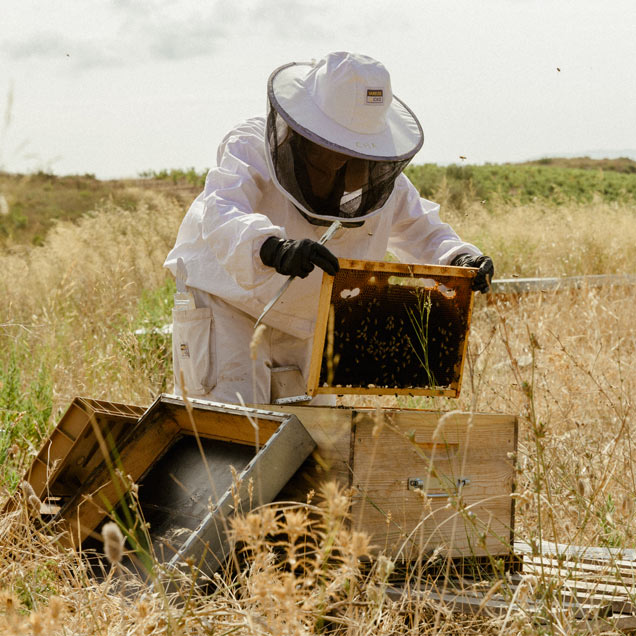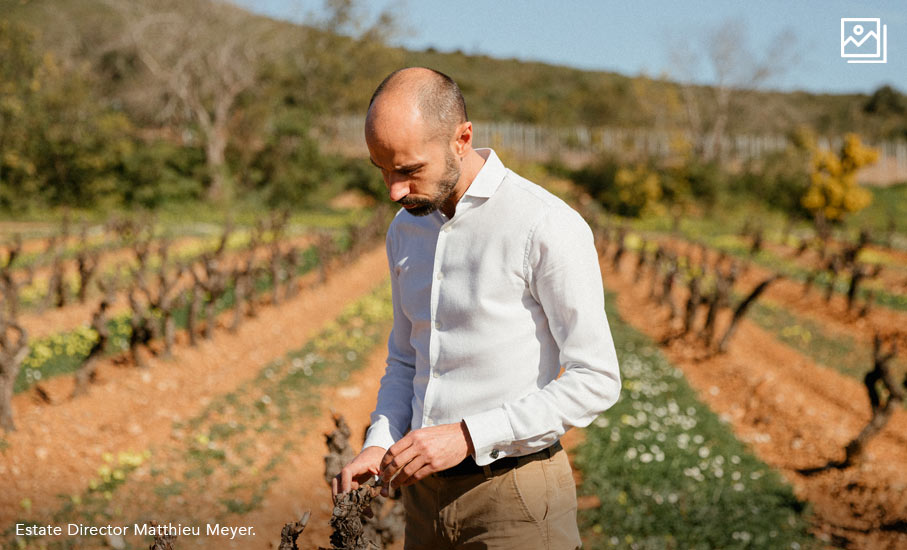When someone embarks on choosing a rosé, possibly not much thought is given to the actual making of the wine. Many decisions are based purely on taste; for some, the country of origin is the key; and for others, a historical or perhaps “fashion” element is the deciding factor.
Two newly launched rosé wines this summer by Château Galoupet – Château Galoupet Cru Classé Rosé 2021 and Galoupet Nomade 2021 – encourage us to think about far more pressing topics. They invite the consumer and connoisseur to think about the future of winemaking and responsible consumption. This progressive wine estate is challenging the status quo of rosé production and drinking with its initiatives, research and processes. The goal from the onset of the project three years ago was to firstly create a sanctuary for biodiversity in Provence and a blueprint for organic viticulture. Secondly, to address sustainability issues around winemaking – as an example, packaging accounts for around 40 percent of carbon emissions in the wine industry. Third, to lovingly and with passion and craftsmanship only known by the French, to produce an amazing wine.
The bee colonies at Galoupet will promote the development of local biodiversity and in consequence, benefit the soil…

Château Galoupet was acquired by Moët Hennessy, the wines and spirits division of LVMH in May 2019, as the first Cru Classé de Provence in the portfolio. In 2019, Jessica Julmy was appointed Managing Director and set about making Château Galoupet a lighthouse of sustainable development for the industry, the region, and the Moët Hennessy group.
The passion that exists at the heart of this winemaking is steeped in vision and a commitment to nature. Preserving processes and practices and improving and supporting the surrounding environment to ensure responsible, environmentally friendly winemaking is what drives Estate Director, Mathieu Meyer, one of a collective of experts developing the blends at Galoupet.
Set approximately an hour’s drive from Nice, nestled between the mountains and the sea, Château Galoupet is a “lieu-dit” (a vineyard with a specific topological identity) marked on a map of the area commissioned by Louis XIV published in the mid-1700s. It has been a Cru Classé vineyard since 1955, evidence of the historical significance of the estate. Its history lies in its unique natural ecosystem: 77 hectares of protected woodland and 69 hectares of vineyards.
Originally, the estate comprised of an olive grove, an orchard, pastures for grazing and a forest of holm oaks, stone pines, eucalyptus, cistus, arbutus, rosemary, lavender and catmint – aromatics found naturally in Provence. The layout hasn’t changed since the reign of Louis XIV, but its ownership has. By the time Moët Hennessy acquired it in 2019, because of the many different hands it has gone through, much of the woodland had been destroyed by forest fires and the soil damaged by chemical inputs.
Château Galoupet Cru Classé and Galoupet Nomade (2021)…

The last three years have been focused on regenerating the soil, nurturing their wines and reviving the biodiversity on the estate. Biodiversity is not a new phrase in the luxury world, many manufactures and brands use it as part of their marketing strategies, so I was keen to find out on my visit what makes Galoupet and its wine unique. The answer is, quite simply, that the list is endless.
On meeting Managing Director Jessica Julmy, I was immediately taken with her commitment and passion to the development of these wines and the care she takes of each aspect of the process. Every intricate detail of production is considered, assessed, and reviewed, again and again. Château Galoupet has a trial and learn ethos, enabling fluidity in processes to ensure the best outcomes for nature are achieved, along with the production of wine. “It’s vital that we look at how we can improve carbon footprint at every stage of the journey,” Julmy explains, “but we are also here to craft wine, so in all of our decisions we are always coming back to aspects like cover cropping, agroforestry, the use of the bees… and studying how all these elements impact our wine.”
As a novice oenophilia, I learnt about Crystalline Provence, the oldest geological formation in the region where the vineyard is located. The individual microclimate that exists on the estate, also enjoys its own natural ventilation system of mistral winds from the north and the sea breeze from the south, which purifies the soil and naturally helps to naturally prevent disease.
Uniquely, the estate is also home to three distinct micro-terroirs spread across 41 plots, each producing a different result, wines with dry fruit flavours, crispiness, or fruitiness and intensity. There are six grape varieties grown on the estate: Cinsault, Grenache, Rolle, Semillon, Syrah, and Tibouren, a rare varietal in the region. This provides a captivating and diverse selection of expressive wines and taste options. As a Cru Classé, Château Galoupet owns 100 percent of its grapes allowing for complete viticulture management and transparency of sustainable practices at every stage. There are also the painstaking processes such as sampling different seed blends, constant reviews of irrigation methods, and trials of a variety of cover crops to assess the impact on soil and vine health to inform future planting strategies. Balancing these elements creates prime conditions for vine growth and development, resulting in richer terroir and more expressive wines.
The breadth of the project doesn’t stop there. Château Galoupet is working with local partners to create action plans to protect and regenerate the ecosystem between the 77 hectares of protected woodland and 69 hectares of vineyards for now and the future.
The CEN PACA (Conservatoire des Espaces Naturels Provence-Alpes-Côte d’Azur) has audited the protected woodland, identifying indigenous plants including parasol pine, cork oak, rare chamomile and more than 90 different species of fauna including 12 of bat and Hermann’s tortoise. There is a three-year action plan to accelerate regeneration of the local species identified.
The LPO (Ligue de Protection des Oiseaux) has audited the biodiversity in the vineyard and will observe and measure the benefits of using cover crop, lower-water consumption, and agroforestry to regenerate the soil.
The OFA (Observatoire Francais d’Apidologie) partnership provides a research centre that is studying and nurturing the Queen Bee population. In 2019, 200 beehives were installed within the estate’s protected woodland and it is now one of only 12 queen bee fertilisation stations in the world. Through their organised presence, these bee colonies will promote the development of local biodiversity, and studies will be made on the impact this can have on soil revitalization.
Mathieu Meyer explains to us on our “educational wine safari” around the estate, that growing research reveals the importance of indigenous plants and pollinators such as bats, butterflies, and most importantly bees, in preserving the balance of fragile ecosystems, and how thriving ecological communities create more complex and beautiful wines. Crafting exceptional and exemplary expressions of the unique terroir of Provence in the most respectful way to the environment is evidenced in his commitment to the partnerships in this long-running project.
Now down to business, the wine! After three years of examining the soils, nurturing the vineyards, and reviving the nature on the estate, the first two rosé wines are launched this summer; both are utterly unique and, as Julmy proudly says, “reflect the generosity, that vitality of Provence wines, and the love and craftsmanship we have invested in them”.
For both wines special attention has been paid to making the packaging as sustainable as possible. “A full realm of recyclable possibilities opened up for us when we didn’t have the constraints of an ageing wine, or pressure from bubbles,” explains Julmy. “We opted for recycled glass and Prevented Ocean Plastic but hopefully one day there won’t be any more plastic in the sea and we’ll be happy to have to find another material.”

Château Galoupet Cru Classé Rosé 2021 is presented in a beautifully embossed amber glass bottle made of 70 percent recycled glass. The flavour is a layered creation working with the varieties of Grenache, Rolle, Syrah and intensely aromatic Tibouren. Brought to Provence by the Romans, Tibouren is a thin-skinned grape with firm, juicy, sweet pulp, that is ideal for making rosé.
Galoupet Nomade 2021 covers a lot of bases. The wine is presented in a flat, ultra-light recyclable bottle, weighing only 63g (almost 10 times lighter than a standard bottle), made from recycled Prevented Ocean Plastic and 40 percent spatially smaller, so it can be delivered directly through a letterbox, which is optimal for ecommerce supply chains and reduces environmental costs. The wine is beautifully light and fresh, harnessing notes of red berries and grapefruit, and consists of a lively blend of Grenache, Syrah, Rolle, and Cinsault. In its uniquely unbreakable yet slim and super-light bottle, Galoupet Nomade is the perfect companion for summer frolics.
Jessica Julmy and her team believe that preserving biodiversity on the Château Galoupet estate is integral to the crafting and evolution of its terroir wine portfolio. Determined to make responsible choices around packaging, “even if it ruffles a few feathers”, Julmy sees this responsibility as something that large groups such as LMVH should carry.
Sustainability from ground to glass – or plastic – is a long-term vision. I will leave you to discover how it tastes.
Galoupet Nomade: RRP £23
Galoupet Cru Classé: RRP £46
















Show Comments +